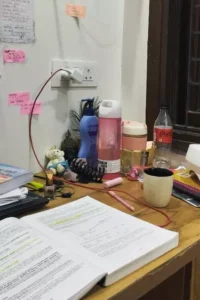Share & grow the world's knowledge!
We want to connect the people who have knowledge to the people who need it, to bring together people with different perspectives so they can understand each other better, and to empower everyone to share their knowledge.
Create A New Account



Does real Rudraksha float on water?
No, a genuine Rudraksha doesn't usually float in water; it usually sinks. A genuine Rudraksha bead is quite dense because it's made of tough, natural seeds with multiple internal chambers. Therefore, when you place a genuine Rudraksha in a container of water, it should usually sink to the bottom. HoRead more
No, a genuine Rudraksha doesn’t usually float in water; it usually sinks.
A genuine Rudraksha bead is quite dense because it’s made of tough, natural seeds with multiple internal chambers. Therefore, when you place a genuine Rudraksha in a container of water, it should usually sink to the bottom.
However, this isn’t a foolproof test to determine whether a Rudraksha is genuine or fake. Some fake Rudraksha beads are so heavy that they even sink. Furthermore, some genuine, but dry or damaged, Rudraksha beads may float because air is trapped inside.
See lessHow to Check If Rudraksha is Real?
To determine if a Rudraksha bead is authentic, several tests can be performed. These include examining the surface texture, counting the Mukhis (lines), looking for natural holes, observing its behavior in water, and using a magnifying glass to inspect its structure. More advanced methods, such as XRead more
To determine if a Rudraksha bead is authentic, several tests can be performed. These include examining the surface texture, counting the Mukhis (lines), looking for natural holes, observing its behavior in water, and using a magnifying glass to inspect its structure. More advanced methods, such as X-rays or CT scans, can also be used to confirm the number of compartments within the bead.
Mukhi Count: Authentic Rudraksha beads have clear, natural Mukhis (lines) running from top to bottom, corresponding to the number of compartments within the bead.
Surface Texture: Authentic Rudraksha beads have a rough, uneven, and natural surface texture. Fake beads may be smooth and polished.
Color and Shape: Authentic Rudraksha beads show natural color variations and have a consistent, natural shape.
Water Test: Place the Rudraksha in water. An authentic bead will sink, but a green or air-filled bead may float. A sinking bead is not necessarily authentic, as some fake beads may contain lead.
Copper Coin Test: Place the Rudraksha between two copper coins. If the bead rotates the coins, it could be authentic. However, this test is not conclusive, as any round object can cause rotation.
Thermal Reaction Test: An authentic bead is resistant to breaking or disintegrating after brief exposure to heat.
X-ray or CT scan: These tests can reveal the internal structure of the bead, confirming that the number of compartments matches the Mukhi count.
Lab Certification: Reputable sellers can provide lab certifications for their Rudraksha beads, verifying their authenticity.
See lessCan UPSC aspirants share pictures of their study room?



See lessI get my teeth cleaned every 6 months. At my last appointment I was told I have 14 cavities, how did this happen?
It sounds like you have an oral infection caused by bacteria that damage and weaken teeth. The main ones are Streptococcus mutans and Lactobacillus. Many dentists simply say, "Stop eating sugar or drinking soda," which is partially true, but the real problem is that sugar feeds these bacteria. To fiRead more
It sounds like you have an oral infection caused by bacteria that damage and weaken teeth. The main ones are Streptococcus mutans and Lactobacillus. Many dentists simply say, “Stop eating sugar or drinking soda,” which is partially true, but the real problem is that sugar feeds these bacteria.
To fix this, you need to change your daily oral hygiene to restore bacterial balance. I suggest the following:
Clean your toothbrush:
Before brushing, soak the brush head in Listerine for at least a minute. This kills any germs on the bristles. Then, rinse it with water before brushing. After brushing, dry your toothbrush and store it where it can air dry. Don’t store it while it’s still wet.
Toothpaste:
The brand doesn’t matter much. Just don’t use a toothpaste that’s too harsh on your teeth. It doesn’t matter if it has fluoride or not, because toothpaste only stays on your teeth for a few minutes.
Use mouthwash to kill germs:
A simple routine:
Important: After using ACT mouthwash, do not rinse your mouth with water. Let the fluoride sit for an hour, if possible, and don’t eat or drink during that time. The fluoride will help repair and strengthen your teeth.
Repeat this entire routine twice a day: once after breakfast and once before bed. At night, the ACT rinse will stay on your teeth until morning.
Note: Listerine is slightly acidic, so you shouldn’t leave your mouth like this for too long. Therefore, you should rinse with ACT right after using Listerine. Closys can be expensive, but you can usually find it at Walmart or larger supermarkets. Use just the right amount to avoid waste.
Use gum or mints with xylitol:
Carry gum or mints with xylitol. After eating or drinking anything, chew a piece or take a mint. Xylitol helps raise the pH of your mouth, making it less acidic. This protects your teeth and prevents bacterial growth. The less acidic your mouth is, the harder it is for bacteria to survive.
Continue like this:
If you follow this complete routine for 5 to 6 weeks, your mouth should regain its health. Cavities won’t magically disappear, but small ones may heal a little. So, if they’re not too serious, you could wait a few months before filling them.
Continue flossing as well: daily at first, but over time you may not need to do it every day because there will be less plaque buildup. Now I only floss occasionally.
Keep this routine up for life to keep your teeth strong and your mouth healthy!
See lessHow long does it take to get 4 cavities between the teeth filled (not big)?
It depends on their location in the mouth and their relationship to each other. In some cases, we can spend almost as much time numbing the patient as we do the fillings. If they are not large (for example, Class I or Class II, i.e., one or two surfaces) and are in the same quadrant/lower side, theRead more
It depends on their location in the mouth and their relationship to each other. In some cases, we can spend almost as much time numbing the patient as we do the fillings.
If they are not large (for example, Class I or Class II, i.e., one or two surfaces) and are in the same quadrant/lower side, the entire appointment could take about 30 minutes. If they are spread across the upper and lower parts, and the right and left sides, more injections will be required, and therefore the appointment will be longer.
See lessHow long should it take to fill 3 cavities?
The size, depth, and proximity to the dental nerve are important. Access and opening width are also important. The jaws are fun to work with. Relaxed patients can become numb in 1 to 5 minutes, while tense and nervous patients usually require 10 to 20 minutes. Working on the distal aspect of the lasRead more
The size, depth, and proximity to the dental nerve are important. Access and opening width are also important. The jaws are fun to work with. Relaxed patients can become numb in 1 to 5 minutes, while tense and nervous patients usually require 10 to 20 minutes.
Working on the distal aspect of the last tooth is a thousand times more difficult than performing two or three tiny dot composites on a person’s midline. Using a hard tissue dental laser is a hundred times gentler than using a high-speed air turbine drill.
See lessHow long does it take to fill a cavity?
Filling a cavity typically takes between 20 and 60 minutes, depending on the size and location of the cavity, as well as the type of filling material used. Smaller cavities may require less time, while larger cavities or those with multiple cavities may take longer.
Filling a cavity typically takes between 20 and 60 minutes, depending on the size and location of the cavity, as well as the type of filling material used. Smaller cavities may require less time, while larger cavities or those with multiple cavities may take longer.
See less